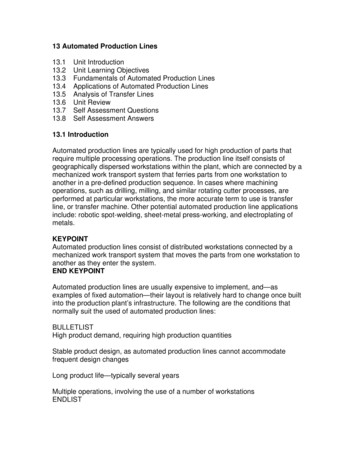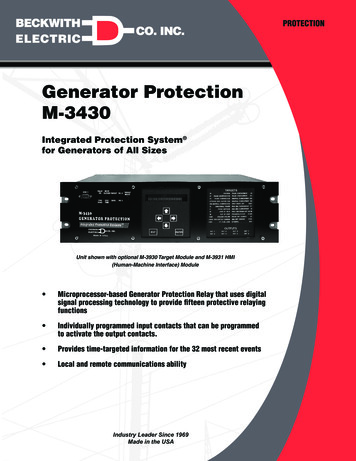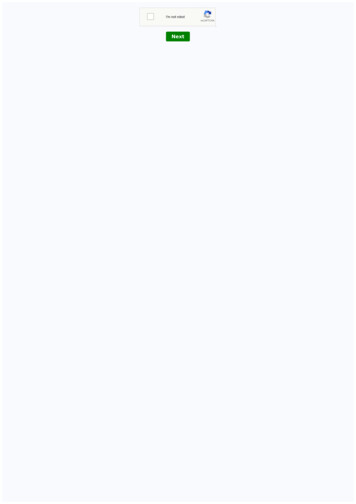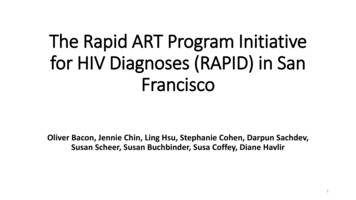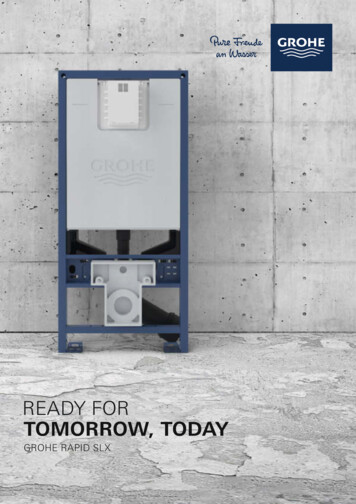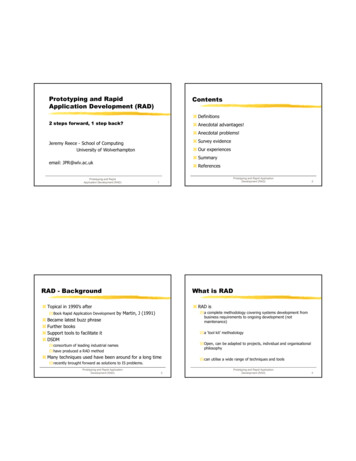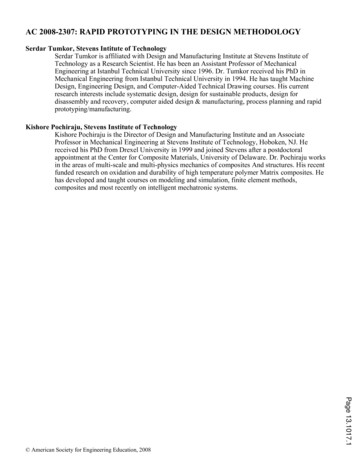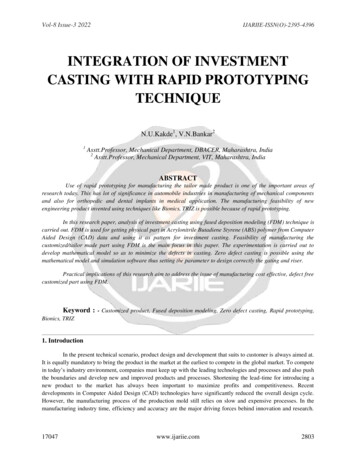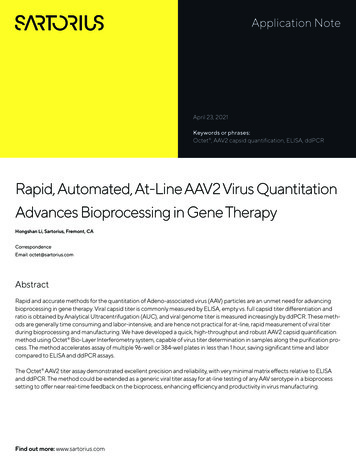
Transcription
Application NoteApril 23, 2021Keywords or phrases:Octet , AAV2 capsid quantification, ELISA, ddPCRRapid, Automated, At-Line AAV2 Virus QuantitationAdvances Bioprocessing in Gene TherapyHongshan Li, Sartorius, Fremont, CACorrespondenceEmail: octet@sartorius.comAbstractRapid and accurate methods for the quantitation of Adeno-associated virus (AAV) particles are an unmet need for advancingbioprocessing in gene therapy. Viral capsid titer is commonly measured by ELISA, empty vs. full capsid titer differentiation andratio is obtained by Analytical Ultracentrifugation (AUC), and viral genome titer is measured increasingly by ddPCR. These methods are generally time consuming and labor-intensive, and are hence not practical for at-line, rapid measurement of viral titerduring bioprocessing and manufacturing. We have developed a quick, high-throughput and robust AAV2 capsid quantificationmethod using Octet Bio-Layer Interferometry system, capable of virus titer determination in samples along the purification process. The method accelerates assay of multiple 96-well or 384-well plates in less than 1 hour, saving significant time and laborcompared to ELISA and ddPCR assays.The Octet AAV2 titer assay demonstrated excellent precision and reliability, with very minimal matrix effects relative to ELISAand ddPCR. The method could be extended as a generic viral titer assay for at-line testing of any AAV serotype in a bioprocesssetting to offer near real-time feedback on the bioprocess, enhancing efficiency and productivity in virus manufacturing.Find out more: www.sartorius.com
IntroductionRecombinant adeno-associated virus (rAAV) is one of themost promising viral vectors in the field of gene therapyfor genetic disorders, as demonstrated by the increasingnumber of clinical trials and promising results. Two productshave received marketing approval, Glybera (uniQure) inEU and Luxturna (Spark Therapeutics) in the US. Yet, theanalytical methods for AAV bioprocess and manufacturing arestill in early stages of development and require continuousenhancement1.Rapid, at-line, accurate methods for the quantitation ofAAV virus particles are essential for bioprocessing in genetherapy. Capsid titer is commonly measured by ELISA,while empty vs. full capsid titer differentiation and ratioare obtained with analytical ultracentrifuge (AUC), and viralgenome titer is measured increasingly by ddPCR2. Currentmethods are time consuming and labor intensive, andhence are not practical for at-line, rapid measurementof viral titer to monitor development of bioprocess andmanufacturing. In this article, we report the developmentof a rapid, high-throughput capsid assay for AAV2 on Sartorius’ Octet platform that demonstrates excellentprecision, reliability in comparison to ELISA and ddPCRthat can be applied as a generic assay method for viral titerat-line in a bioprocess setting.Octet System and Bio-LayerInterferometryThe principles of concentration measurement with anOctet system are similar to established immunoassayssuch as ELISA. However, quantitation protocols on theOctet platform provide several advantages. The Octet platform monitors binding of analyte from solution to abiosensor surface in real time, without need for labels,secondary binders or other detection reagents. Thisreal-time monitoring of binding interactions enables cleardiscrimination between specific and non-specific bindingsignals, which can shorten assay development timesdramatically. Octet quantitation assays are also much faster: quantitation of a 96-well plate of samples can be performed in 5–60 minutes, depending on the instrumentmodel.Octet systems are routinely used for protein characterization across various stages of biotherapeutics R&D, measuring binding affinity and kinetics of drug-target interactionsas well as measuring protein concentration in bioprocesssamples. The same principle in use for quantitation of protein2therapeutics is applied here for the analysis of AAV virusparticles. The Octet platform uses a simple Dip and Readapproach for rapid analysis of samples in 96- and 384-wellmicroplate formats. The concentration of the target virusparticles in a sample is determined via a direct bindingassay. Biosensors coated with a capture molecule, calledthe ligand, are dipped into solutions containing the analytein a highly parallel, automated method to measure bindinginteractions. In a typical quantitation assay, a standard curveis generated using known amounts of the analyte, andunknown sample concentrations are interpolated from thestandard curve. Concentrations can be calculated from theinitial binding rate of the interaction which is based on theinitial slope of binding or from the point at which bindingreaches an equilibrium.In this application note, we describe the development ofan assay for quantifying AAV2 virus particles. The assaywas constructed by capturing AAV2 virus using heparinimmobilized onto Streptavidin Biosensors. We show thatthe working assay can be used to quantify AAV2 particlesfrom purified as well as complex bioprocess matrices witha dynamic range of 4.15 108 – 2.66 1010 gc/mL (genomecopy/mL). Depending on the Octet instrument used, thequantitation assay can be completed in as fast as 30 minutes,significantly accelerating assay timelines compared toELISA and ddPCR based methods. The Octet assay canbe extended to any AAV serotype by using an appropriatecapture molecule and following the assay developmentsteps described chingVirusbindingFigure 1: Octet AAV2 assay workflow. The assay method can be extended to any AAV serotype using an appropriate biotinylated capture molecule and following the steps described herein.Method DescriptionSartorius’ Octet AAV2 virus assay is designed for monitoringAAV2 virus concentrations in crude lysate and cell culturesupernatant (Figure 1). High Precision Streptavidin Biosensors (SAX) supplied by Sartorius are first coated withbiotinylated heparin and then blocked with biocytin.Heparin-coated biosensors can be batch-prepared inadvance using Sartorius’ batch biosensor preparationprotocols and stored for future use.
-----Materials RequiredOctet instrument with Octet BLI Discovery andAnalysis Studio Software (v11.1 or higher).High Precision Streptavidin (SAX) Biosensors,Sartorius part no. 18-5117Sample plates: 96-well, black, flat bottom, polypropylenemicroplate, Greiner Bio-One part no. 655209 for Octet R8 systems and 384-well tilted (Sartorius part no.18-5080) or flat-bottom black polypropylene microplate1 PBS, Dulbecco’s phosphate buffered saline,Sigma part no. D8662Biotin-Heparin (Creative PEGWorks part no. HP-207)EZ-Link Biocytin, Thermo Scientific part no. 28022Stock of the purified AAV2 virusSartorius sample diluent, part no. 18-1104 (recommended)or buffer of choice. A dilution of 1:100 of the sample indiluent is recommended for best performance.-Shaking speed and assay time should be optimizeddepending on the AAV serotype. For AAV2, a shakingspeed of 400 rpm was selected and used for the assay.Setting up Basic Kinetics experiment in the ExperimentWizard.The loading level of biotinylated heparin on the SAX Biosensor should be screened in a scouting experiment withvarying concentrations of biotinylated heparin (Figure 2).For AAV2, 25 μg/mL of biotinylated heparin was used toachieve ligand loading signal saturation in a 5-minute incubation step. A 30-second quenching step using 25 μg/mLof biocytin prepared in PBS follows before the biosensorscan be used to detect AAV2. The quenching step is criticalto the prevention of non-specific binding (NSB).0.600.50AAV2 Assay Development andOptimization--Binding (nm)The first step in developing a working assay is the identificationof a capture molecule herein referred to in this procedureas a ligand. The ligand should bind specifically to the antigenof interest and should be screened for optimal captureconcentrations. In selecting a ligand for the Octet AAV2assay, biotinylated versions of various receptors andanti-AAV antibodies were screened against an AAV2 positivecontrol sample (data not shown). From the screeningexperiment, biotin-heparin was selected as the ligand tobe loaded on the biosensor, due to good performance onAAV2 detection sensitivity and quantitation dynamic range.0.400.30100 µg/mL25 µg/mL12.5 µg/mL6.25 µg/mL0 µg/mL0.200.100-0.050100150200250300350400Time (sec)Figure 2: Biotin-heparin loading concentration scouting assay.We also evaluated and determined the following conditionsas optimal for assay performance:Fully equilibrate all reagents and samples to roomtemperature prior to sample preparation. Thaw frozensamples completely and mix thoroughly prior to use.Hydrate the biosensors with 1 PBS for a minimum of10 minutes prior to use.Sartorius recommends running assays at 30 C, and usingother temperatures may require modifying the assaytimes discussed in this protocol. To set the sample platetemperature in Octet System BLI Discovery Software,select File Experiment Set Plate Temperature andenter the desired temperature.3
AAV2 Standard Curve PreparationAAV2 standard curve is prepared using purified AAV2 ofknown concentration. A series of standard dilutions ofpurified AAV2 is used for the dynamic range determination study.Prepare 1 mL of each standard sample by diluting the stocksolution with an appropriate amount of sample diluent.Standard sample concentrations can be adjusted to reflectthe working range of the standard curve. A typical platemap is shown in Figure 3 while Figures 4 and 5 showsuggested calibrator sample dilutions to determine thedynamic range and assay workflow design.Figure 3: Plate map with standard samples. Sample wells are shown inpink (B: buffer; L: loading; Q: quenching).Figure 4: Setting up the AAV2 virus quantitation experiment. Figure highlights plate map and concentrations of the known samples.Figure 5: Octet Software set up for AAV2 virus quantitation experiment. Figure shows plate design and assay step sequence and parameters.4
AAV2 Virus Binding and StandardCurve GenerationUsing the described assay setup and the standard biosensorhydration protocols (10 minutes hydration in assay buffer),the AAV2 virus binding assay is run at an rpm of 400. Assaytimes for each step is shown in Figure 5. A zero gc/mL(sample diluent only) sample well is used as a negative control.An example of binding raw data for calibrator or test samplesis shown in Figure 6.The virus capture step in Figure 6 is analyzed using theOctet BLI Discovery Software to generate a calibrationcurve as shown in Figure 7. The analysis software usesthe established calibration curve to generate test sampleconcentrations. Table 1 shows an example of an AAV2 Virusquantitation assay with good precision up to 2.66 1010 gc/mLobtained. The standard curve should cover the range ofunknown samples. To obtain the most accurate results onestandard sample needs to be above the range ofquantitation detected for the assay. In the AAV2 example,the recommended range for best precision and accuracy is4.15 108–2.66 1010 gc/mL. Some AAV virus serotypes mayhave a more limited dynamic range while a broader dynamicrange could be appropriate for others. Dynamic range mayalso be influenced by the nature of the AAV2 virus sample.In general, the actual dynamic range will be dependent onthe virus of interest.All steps aligned by step association (biosensor location)LoadingQuenchingVirus capturingVirus capturing1.01.00.80.80.6Binding (nm)Binding (nm)0.40.200.60.4-0.2-0.40.2-0.60-0.80200400600800 1000 1200Time (sec)1400 16001800100012001400Time (sec)16001800Figure 6: Full binding sensorgram of AAV2 detection on SAX Biosensors: The SAX Biosensors are first immobilized with biotinylated-heparin, quenchedwith Biocytin and associated with different concentrations of AAV2 samples. The Octet assay is complete within 30 minutes.0.9Binding Rate0.70.50.30.10050100150200250300Sample IDKnown conc.(*108 gc/mL)Conc. avg(*108 gc/mL)Conc. CV(n 2)Standard 1266206.50.8Standard 2133133.11.7Standard 366.571.41.1Standard 433.230.58.7Standard 516.617.63.3Standard 68.38.49.5Standard 74.34.35.4Neg Control000Table 1: Displays calculated average concentrations and % CV determinedfor a quadruplicate calibrator series ranging from 4.15 108–2.66 1010 gc/mL.Concentration (µg/mL)Figure 7: AAV2 standard curve.5
Note: If the unknown virus samples you want to quantifyare bioreactor AAV2 virus with a changing media matrixthroughout the bioreactor run (for example, media supplementing), dilute the sample 1:100 to eliminate the matrixinterferences.Data Analysis1. Open the Octet Analysis Studio Software. Select thecolumn(s) from Data Selection/Sensor-Assay and clickon Processing. Click on the association step and chooseQuantitate Selected Step. Then click on Yes to the popup window and the quantitation window will display.Click on Results and choose 4PL (weighted Y2) forStandard Curve Equation use Requilibrium for BindingRate Equation and click on the Calculate Binding Rate!Save report.2. Copy the data table into Microsoft Excel and determine the % CV of the calculated calibrator calculation.% CV (standard deviation/average)*100. CV can alsobe automatically calculated by the data analysis softwarewhen the Replicate Group information is filled duringassay setup.3. The dynamic range of the AAV2 virus assay is the continuous range for which the % CV of quantitation is 10%.4. Examine the calibration curve and verify that replicatedata points on the graph are not overlapping.Overlapping data points would indicate that thecalibrators are not clearly distinguishable.5. Select the dynamic range according to the criteria listedprior or based on your assay criteria. In order to quantifycorrectly in the highest desired range, add the nexthigher level to your calibration curve.6. Unknown AAV2 virus samples should be subsequentlydiluted into the established assay range (see Table 2).Spike Recovery TestTo test the effect of different matrices, the AAV2 samplewas subjected to dilution in different buffers. A controlsample was first diluted 1:5 in different buffers, then dilutedagain 1:20 in Sample Diluent as the starting material.A spike and recovery test was performed using SampleDiluent. Good recovery ( 90%) with low CV ( 15%) above6.25 108 gc/mL (Table 2) across different buffer systemsindicate that the assay works well in different bioprocessbuffer systems (Figure 8).6Table 2: AAV2 spike recovery test in different media.Assay buffersSpiked conc.(*108 gc/mL)Calculated conc.(*108 gc/mL)Recovery(%)Sample diluentAssay buffers99.199.1TE 0.1% pluronic100104.6104.6Medium100103.6103.6Lysis buffer10092.792.7Sample diluent5049.999.8TE 0.1% pluronic5051.7103.4Medium5051.5103.0Lysis buffer504794.0Sample diluent2523.292.8TE 0.1% pluronic2529116.0Medium2522.389.2Lysis buffer2525.4101.6Sample diluent12.511.995.2TE 0.1% pluronic12.514.1112.8Medium12.510.684.8Lysis buffer12.513.8110.4Sample diluent6.256.41102.6TE 0.1% pluronic6.256.1297.9Medium6.254.8377.3Lysis Buffer6.258.28132.5Sample diluent3.132.7587.9TE 0.1% pluronic3.133.0998.7Medium3.133.199.0Lysis buffer3.134.72150.8120100Recovered Conc. (*10 8 gc/mL)It is also important to ensure that there is sufficientseparation between each standard level and that theydo not overlap.806040Sample DiluentTE 0.1% PluronicMedium200Lysis Buffer020406080Spiked Conc. (*10 8 gc/mL)Figure 8: AAV2 spike recovery comparison.100120
AAV2 Virus Quantitation ReproducibilityAssessmentFor reproducibility assessment, two samples, before(sample A) and after (sample B) the filtration enrichmentwere analyzed in duplicate. Results in Table 3 show goodconsistency with R2 values at 0.99 and CVs of less than 10%.A comparison between the Octet assay, ddPCR and ELISAis highlighted in Figure 9. The data suggests very comparableresults between the three techniques; Smilar trends wereobtained using ddPCR, ELISA and Octet methods forboth sample A (before filtration enrichment) and sample B(after filtration enrichment). Results further clearly showthe AAV vector titer improves with enrichment.A key application in bioprocess optimization is the monitoring of recovery during virus purification. To test whetherthe Octet assay could be used to assess the purificationprofile of AAV2, 7 different samples from various purificationsteps were diluted 100x in Sample Diluent and analyzedin the same run. Figure 10 shows that different bioprocesssamples can be detected simultaneously in less than30 minutes. This assay time can be further optimized forat-line monitoring of bioprocesses.SampleBinding rateCalc conc.(*108 gc/mL)Dilution factorConc.(*1012 gc/mL)Avg. conc.(*1012 0.794292.32001.841.757.69Table 3: Two samples from different virus purification processes were analyzed in duplicate.Sample Quantitation1800161600141400121200gc/mL (*E8)#/mLComparison of AAV2 Quantitation18108100080066004400220000ddPCROctet Before EnrichmentELISAAfter EnrichmentFigure 9: Comparison of ddPCR, ELISA, and Octet platforms[#/mL: gc/mL(ddPCR and Octet); capsids/mL(ELISA)].S1S2S3S4S5S6S7Processed SamplesFigure 10: Octet AAV2 titer determination for bioprocessing samples.Samples were obtained from different purification steps and assayedsimultaneously.7
DiscussionReferencesThe operating procedure for Octet instruments is simpleand straightforward. Since it is a Dip and Read method withsamples placed in microtiter plates, sample purification is notnecessary, resulting in significant sample preparation timesavings. The technology is highly versatile and can be usedbroadly to design multiple AAV serotype-specific titer assays.Here we have developed a fast, high-throughput and robustAAV2 capsid quantification method using the Octet platform.The titer values measured by the Octet assay correlate wellwith results obtained from ELISA and ddPCR. The Octet assay afforded an approximately 2-log dynamic range. Theassay is capable of quantifying process-related samples.Samples can be quantified in less than one hour comparedto approximately 5 hours for ELISA and about 8 hours forddPCR for a similar number of samples. The Octet quantitation assay is a robust analytical method for titer measurementof any virus particle by coating the appropriate capture ligandon a biosensor. We postulate that rapid and easy viral titermeasured at-line enables near real-time feedback on thebioprocess, thereby saving significant resources and timefor virus manufacturing.1.GermanySartorius Lab Instruments GmbH & Co. KGOtto-Brenner-Strasse 2037079 GoettingenPhone 49 551 308 0F or further contacts, visitwww.sartorius.com/octet-supportSpecifications subject to change without notice.Copyright Sartorius Lab Instruments GmbH & Co. KG.For Research Use Only.FB 4019 Rev CDownstream bioprocessing of AAV vectors: industrialchallenges & regulatory requirements, Hebben M, Celland Gene Therapy Insights, 2018, Mar 14, pp. 131-146.2. Accurate Quantification and Characterization ofAdeno-Associated Viral Vectors, Dobnik D et al.,Microbiol. , 2019, 10:1570. doi: 10.3389/fmicb.2019.01570.USASartorius Corporation565 Johnson AvenueBohemia, NY 11716Phone 1 888 OCTET 75Or 1 650 322 1360
Application Note Rapid, Automated, At-Line AAV2 Virus Quantitation . In this article, we report the development of a rapid, high-throughput capsid assay for AAV2 on Sarto- . In the AAV2 example, the recommended range for best precision and accuracy is 4.15 10 8-2.66 10 10 gc/mL. Some AAV virus serotypes may



